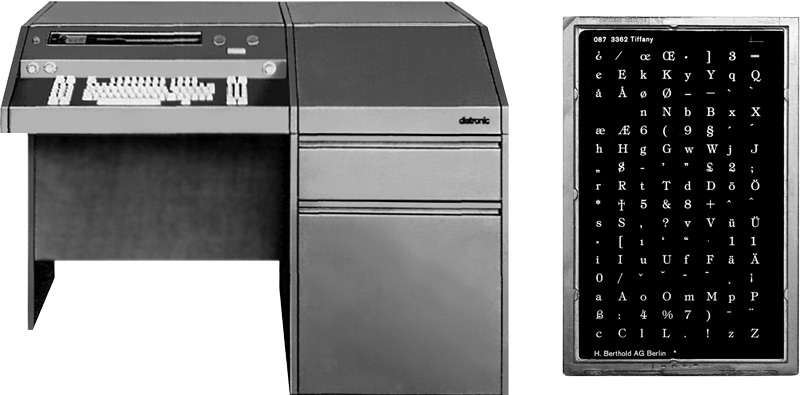In 1967 Berthold introduces its Diatronic phototypesetting system, shown to the left below. It combines a keyboard, computer and opto-mechanical imaging unit. Above the keyboard is a single line screen on which the operator can see the most recently typed characters. The unit can hold up to 8 typefaces. To the right is an example of such a typeface plate which contains 126 characters. The optical system can project these typefaces onto the photo paper in sizes from 6 to 20 points. There are elaborate options to create complex tables. The typesetter is the first one that can also output horizontal and vertical lines.
That same year Mergenthaler Linotype introduces a CRT typesetter, the Linotron 1010, which is developed in conjunction with CBS Laboratories. It can output up to 15 million characters per hour and is used at the U.S. Government Printing Office in Washington.
Océ enters the office printing market with an electro-photographic process for copying documents using a special chemically-treated type of paper.
ISBN is started in Britain. The International Standard Book Number is a unique numeric identifier for commercial books.
The drupa trade show continues to expand with 267 additional exhibitors. Stackers get special attention during this edition. Koenig & Bauer show off their new Rapida offset presses while the Kombi-Chromagraph CT288 from Hell can combine scans of text and images on a film.
German typographer and designer Jan Tschichold creates Sabon. It is released jointly by the Linotype, Monotype, and Stempel type foundries.

Another typeface released that year is Serifa, a slab serif typeface created by Adrian Frutiger. Its design is based on Univers.
These are some important or remarkable events from 1967:
- Louis Leakey announces the discovery of pre-human fossils in Kenya.
- All over the US large demonstrations are held against the Vietnam War.
- The Beatles release Sgt. Pepper’s Lonely Hearts Club Band, the unofficial ‘Soundtrack of the Summer of Love’.
- Israel takes on the allied armies of Egypt, Syria, Iraq, Jordan, and Iraq in the Six-Day War.
- The first pulsar, a highly magnetized rotating star, is discovered.


Beste Mike, die “prismadoos” is het “stellwerk”. De prima’s kon men alleen in de fabriek in Berlijn repareren. Ik, toen der tijd werkzaam bij Berthold in Amsterdam konden de letterschijf justeren. Het ringkerngeheugen had 8 posities. De S had er 124. Een zwakke S voeding maar van schade door een ontploffing heb ik nooit gehoord. Ik werkte bijna 20 jaar voor Berthold Fototype en maakte het faillissement mee in Duitsland. Toen is ook de typografie ten onder gegaan.
The computer in the Diatronic was primitive by modern standards. It had a magnetic core memory which I believe was either 2K or 4 Kbytes. The computer in the Diatronic S was more sophisticated but they both used the same electro/mechanical/optical “prism box” for selecting characters which was very tricky to re-align if it needed repairing. Also the power supply in the “S” used a very large smoothing capacitor which on more than one occasion failed with a loud bang and left a dent in the casing, an event which wasn’t popular with operators. They were however popular with advertising agencies because they produced high quality type.
Great comment!
Talk about an OBSCURE machine in the U.S.! I actually operated a Diatronic S in 1979. I believe it was the only one in Portland, OR at the time. Company owner said it cost over $150,000 (in 1979 dollars). We had the futuristic punched tape unit for job storage (not sure if that was “premium” option) and quite a few font families at several hundred bucks a pop. Along with precise kerning and leading functions, the output from this beast was quite beautiful and in demand by Portland’s top ad agencies. In 1983, we upgraded to Compugraphic’s first WYSIWYG capable system, the MCS. By the early 90’s though, both machines were covered in dust, abandoned way back in the warehouse somewhere, the glory days “real” typesetting gone forever.
Wow, amazing. I also operated a Diatronic at Typex Graphics in Vancouver, BC. The first Canadian company to have one. I later moved to Cleland Kent in Vancouver who had the ADS. After this came the MSeries which I also operated in Toronto. One good thing was always being paid a top wage, and being in demand. Brilliant time.